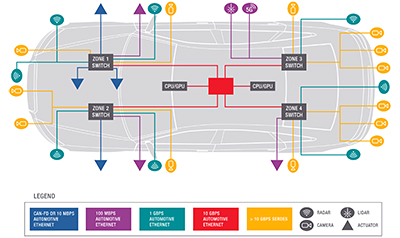In this two-part guest commentary, Carrie Browen and Kevin Kershner from Keysight Technologies share their insights into the future of high speed in-vehicle display and sensor connections.
It is no secret the pace of innovation in the automotive industry is exploding.
If the last 20 years have been linear in the development of electrification, the last two to three years have been exponential.
Bandwidth Requirements
To get a better understanding of the bandwidth requirements, remember that the approximate bit rate of a video stream can be calculated as follows.
- Frame Size = Resolution x Color Depth
- Bit Rate = Frame Size x Frame rate
So, for an ADAS camera capturing a 1080p image, with a color depth of 24-bits and transmitting at 30fps, the bit rate to be supported equals:
- Frame Size = 1920 x 1080 x 24 = 49,766,400
- Bit Rate = 49,766,400 x 30 = 1,493 Mbps
It used to be that a car was a means of getting from A to B.
Now, we can safely say that is not true for the vehicles of today and certainly not for the new vehicles of tomorrow.
Just about every new car on the market has a backup camera, park assist, and blind spot monitoring.
Some offer a 360-degree view.
Other features offer real-time traffic updates, cellular connection to potential hazards, other road users, vehicles, or pedestrians.
There are features that can detect if a driver is distracted or tired.
Meanwhile, the people in the car are often unaware of driving conditions, while they enjoy infotainment systems.
These features are delivered through a mixture of sensors, cameras, and networks.
As demands go up, next-generation advanced driver-assistance systems (ADAS) require camera and radar systems with increasingly high resolution.
That means more speed and bandwidth for networks, switches, and the connections that carry the data.

Typical volumes of data from the different sensors involved in autonomous driving.
Innovation in automotive technology has rapidly accelerated to accommodate advanced automotive technologies that run at greater than 1 Gbps data rates over existing cabling infrastructures.
Higher bandwidth and lower latency networking will play a critical role in addressing time-sensitive and complex automotive technologies to come.
Many of these requirements can be met by automotive Ethernet with a bandwidth of up to 10 Gbps.
When you consider the requirements for some of the cameras are up to 3,500 Mbps, we must also consider another technology to move that data around.
Industry requirements
The automotive market is driven by many motivators.
A few of the most influential motivators in the automotive market are listed below.
- Increasing demand for high bandwidth and lightweight materials
- Rising demand for driver assistance systems
- Rise in demand for luxury vehicles
- Future-proof technology
- Improved data security
We have already established the need for high bandwidth technologies and keeping weight down to maximize fuel (or battery) efficiency.
 Carrie Browen is the autonomous vehicle business line product manager for Keysight Technologies.
Carrie Browen is the autonomous vehicle business line product manager for Keysight Technologies.
With over 20 years in the industry, she is responsible for translating and articulating Keysight solutions to convey the most important points to those that would find value in them.
Carrie has a BS in electrical engineering, lives and enjoys the Colorado mountains, likes to garden, is horrible at hula hooping and can be convinced to try new things especially by her 3 teenage boys.
All the sensors for backup views, parking, and lane-change assist, not to mention newer heads-up and co-driver displays, plus any additional infotainment systems, stems from the demand of ADAS and autonomous vehicle (AV) technologies.
In addition, network architects need to understand how the vehicle will be required to scale as the technology improves.
Today, the expectation is that you will have a car for 10 to 15 years.
If cost-effective interconnect solutions can provide support for additional bandwidth, they may need to consider designing them today to allow for added ADAS/AV heavy features customers will want during the life of the vehicle.
And of course, safety is another ultra-important area for vehicle design.
As more AV and ADAS features take over functions from humans there is a very big focus on passenger safety.
Zonal architecture
Engineers are always trying to reduce complexity, and this is true with in-vehicle networking.
 Kevin Kershner is responsible for defining the requirements for Keysight’s future IVN solutions.
Kevin Kershner is responsible for defining the requirements for Keysight’s future IVN solutions.
Kevin actively participates in MIPI A-PHY, ASA and VESA standards meetings.
With 16 years in the industry, he is particularly good at understanding a technical issue from all angles and explaining it to others.
Kevin has a BS in Electrical Engineering from UCLA, and currently lives near Chicago.
Kevin’s passions outside of work include bicycling, general aviation, and traveling the world with his wife.
The cover image above is an abstract version of a vehicle using many different data rates in the backplane.
It is an oversimplification, but for the sake of this discussion, it helps us imagine how some of these technologies and standards work together.
A zonal architecture will pull together multiple inputs and ultimately lower the complexity, cost, and weight of the wiring harness, transitioning from a “many to one” architecture to a daisy-chained, one-to-one architecture.
This is an example of a zone-based architecture, while others are considering a domain-based architecture.
Both will aggregate camera and sensor data, where Ethernet acts as an interconnect between each zone or domain.
Because a central computing complex is linked to the sensors and devices through networked zonal gateways, a zonal approach can provide better scalability as well as improved reliability and functionality.
Tomorrow we shall introduce you to SerDes and the various forms of physical layer testing involved.
Tags: insights, Keysight, opinions, SerDes, Tech Focus, technology, vehTech
